Prospective application of poloxamer 188 in plastic surgery:A comprehensive review
Yuji Shng ,Shiou Zhu ,Fngfei Nie ,Yonghun Zhen ,Pengbing Ding ,Dong Li,* ,Hu Li,Yng An,*
aDepartment of Plastic Surgery,Peking University Third Hospital,Beijing 100191,China
bDepartment of Natural Products Chemistry,School of Traditional Chinese Materia Medica,Key Laboratory of Structure-Based Drug Design & Discovery,Ministry of Education,Shenyang Pharmaceutical University,Shenyang 110016,China
c State Key Laboratory of Biotherapy and Cancer Center,West China Hospital,and Collaborative Innovation Center of Biotherapy,Sichuan University,Chengdu 610041,China
Keywords:Poloxamer 188 Plastic surgery Autologous fat grafting Wound healing Cartilage transplantation
ABSTRACT An increasing number of researchers have demonstrated that poloxamer 188 (P188) can be used as a pharmaceutical excipient for clinical applications.Its membrane-sealing effects and inherent biological activities make it an extremely promising agent for plastic surgery.In this review,we summarize the positive roles of P188 in autologous fat grafting,wound healing,and cartilage transplantation.These roles include improving the survival rate of fat grafts and chondrocytes,stimulating the metabolic activity of adipocytes,promoting wound healing,and contributing to cartilage formation.Although further research is still needed,it is clear that P188 has great potential and application value in the field of plastic surgery.
1.Introduction
Plastic surgery integrates healing,correction,and reconstruction,and was first established based on basic techniques and related anatomical research.However,in recent years,with a deeper understanding of cell biology,wound healing,and tissue regeneration,more innovative technologies and drugs have begun to be used in plastic surgery treatments.At present,commonly used drugs in plastic surgery clinics include filler hyaluronic acid,antibiotics,growth factors,and botulinum toxin.Even so,there are some limitations in their further clinical development,such as complications,immune allergic reactions,cytotoxicity,and high prices.1–4As a result,it is necessary to find drugs that can effectively solve the existing problems.Poloxamer was initially used in clinics as a pharmaceutical excipient5;however,because of its low toxicity and good biocompatibility,its applicability in the field of plastic surgery has attracted increasing attention.Poloxamers are triblock copolymers composed of polyoxyethylene (PEO) and polyoxypropylene (PPO) segments in different proportions.6,7As the ratio of PEO:PPO is changed,there are many different models that differ in molecular weight,composition,physical state,and other aspects (Table 1).Among them,poloxamer 188(P188)is regarded as the most promising poloxamer used in plastic surgery owing to its cell membrane-reparative effect and other biological properties.8,9
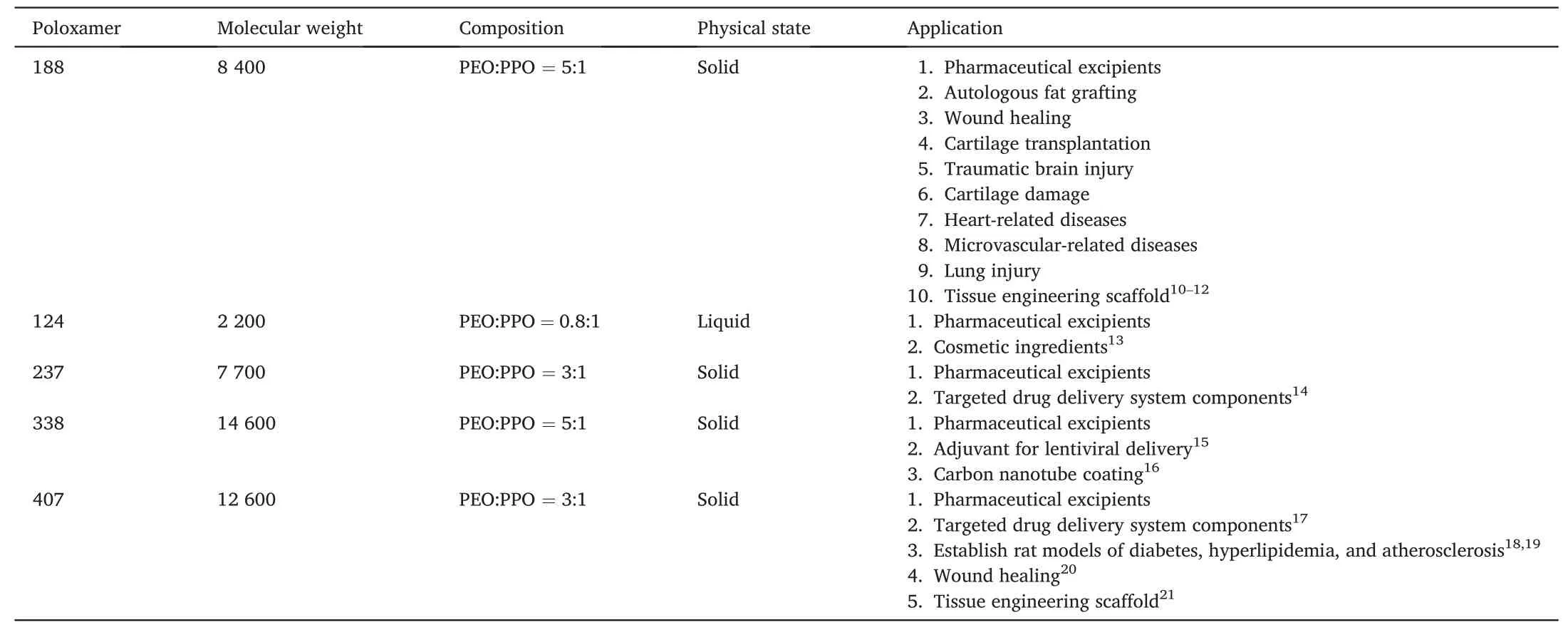
Table 1 Comparison of several common types of poloxamers.
Previous review articles on P188 have mainly introduced the application of P188 as a membrane sealing agent10;however,a few articles emphasize the inherent biological activity of P188 itself.In addition,current research mainly discusses the basic characteristics and clinical applications of P188,but there is no comprehensive review article on P188,with focus on plastic surgery.Therefore,in this paper,we especially focus on the principle and application value of P188 with respect to several aspects of plastic surgery,such as autologous fat grafting,wound healing,and cartilage transplantation.
2.Basic characteristics of P188
2.1.Solubility
P188,also known as Pluronic F68,is a block copolymer with hydrophilic polyoxyethylene accounting for approximately 80% of its compostion.22Therefore,it easily dissolves in water regardless of itsmolecular weight,but it is almost insoluble in some organic solvents such as ether or petroleum ether.
2.2.Surface activity
P188 is composed of triblocks containing a central hydrophobic chain and two hydrophilic chains on both sides.Its hydrophilic-lipophilic balance is 29;therefore,it has strong surface activity.P188,acting as a surfactant,can reduce blood viscosity and red blood cell aggregation.23Moreover,recent studies have shown that it can seal damaged membranes of many cell types based on its surface activity.24–26
The surface pressure of the normal cell membrane is 30 mN/m,and when the cell membrane is damaged,its surface pressure decreases.A surface pressure equal to or less than approximately 22 mN/m will help P188 selectively adsorb to the damagedpart of the plasma membrane.27,28At this time,the central hydrophobic part of P188 can interact with the exposed hydrophobic part of the damaged cell lipid bilayer.In addition,the chain can fold so that its hydrophilic end is positioned along the outer hydrophilic surface of the cell membrane.29Then,the surface pressure of the cell returns to the normal level and P188 is squeezed out.30Finally,P188-mediated repair of the damaged membrane is completed(Fig.1).
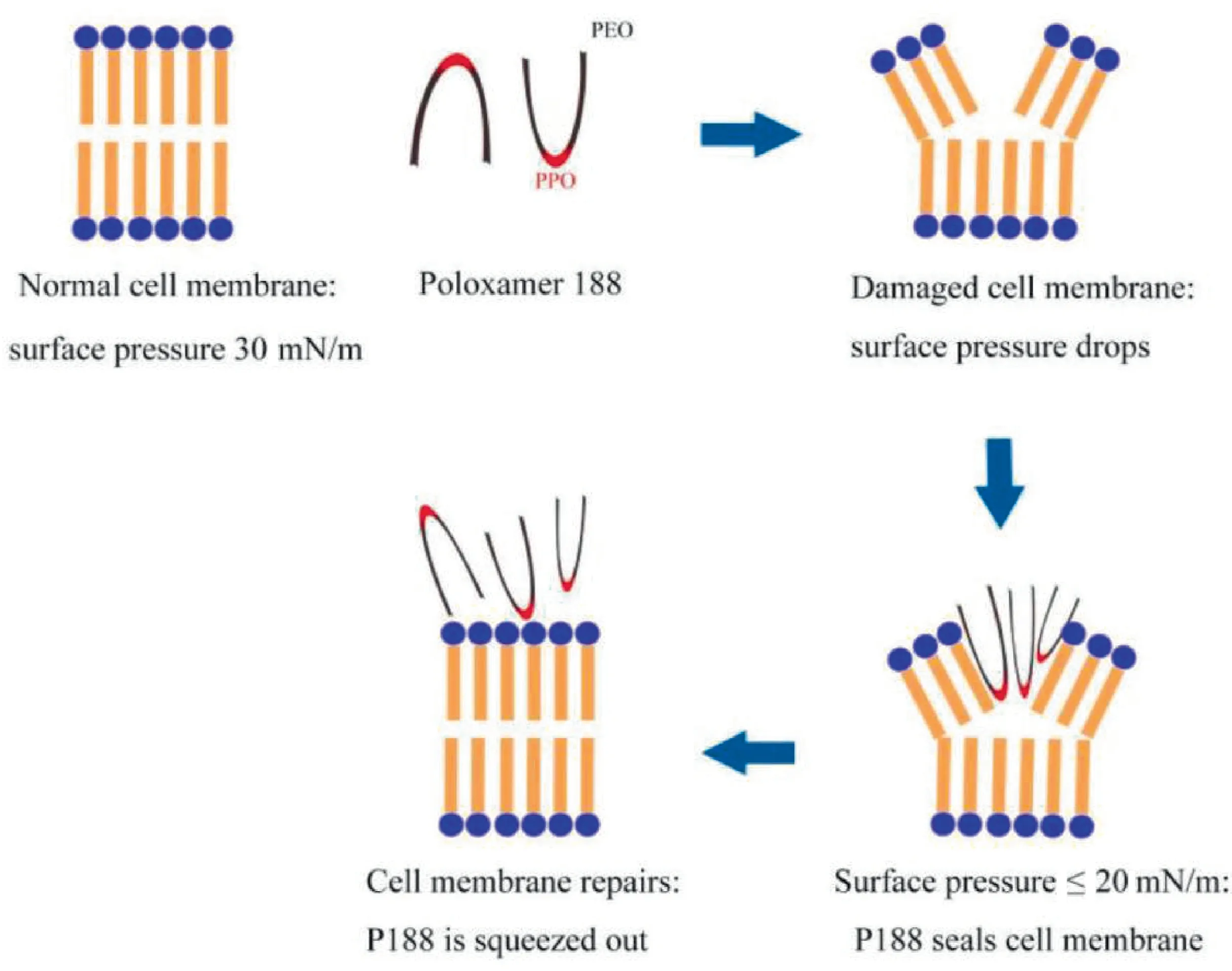
Fig.1.Membrane repair process of P188.P188,poloxamer 188;PEO,polyoxyethylene;PPO,polyoxypropylene.
2.3.Biological activity
In addition to its solubility and surface activity,P188 also has certain biological activities.For example,Wen et al.31showed that P188 itself has an anti-inflammatory effect;the research of Doˇgan et al.32demonstrated that P188 can promote osteogenesis,cartilage formation,and fat differentiation.Moreover,some studies have concluded that P188 can prevent damage and apoptosis by itself,exerting its protective effects.29,33
3.Application value of P188 in autologous fat grafting
Autologous fat grafting is a common technical method used in plastic surgery.It has become the gold standard for repairing soft tissue defects.Owing to the rich source and easy access of autologous adipose tissue,as well as its good tissue compatibility and low allergicity,34,35it is widely used to treat tissue defects,fibrosis and scarring,and systemic sclerosis as well as for breast augmentation and remodeling.36However,since autologous fat grafting is affected by many factors,it still faces problems such as long-term instability,poor retention rate,and low survival rate,which need to be solved urgently.37
In fact,an increasing number of studies has inspired us to conclude that P188 has great application potential in autologous fat grafting.A previous study compared the quantity and quality of fat aspirates processed by the Poloxamer Wash,Absorption,and mesh filtration System(PWAS)with the commonly used Ringer’s Lactate wash,Decant,and mesh filtration System(RLDS),and the final result suggested that the fat volume fraction treated by PWAS was greater than that with RLDS.38Another study used various types of poloxamers or poloxamer components to treat fat grafts for 10 days or 6 weeks and then evaluated multiple indicators and found that among these poloxamers,P188 performed best and was associated with greater improvements in weight,cell viability,DNA content,and histological appearance compared to those in the control group.29
In the process of autologous fat grafting,it inevitably causes a certain degree of damage to the adipose tissues,accompanied by inflammatory reactions,which also affects the survival rate of the graft.P188 could inhibit mRNA and protein expression of inflammatory cytokines,such as IL-1,IL-6,and TNF-α,indicating that P188 had an inhibitory effect on inflammatory infiltration after autologous fat grafting in rats,and it can subsequently improve the survival rate of fat grafts.39Therefore,adding P188 to autologous fat grafting is expected to solve the problem of low graft survival rates.
In addition to its effect on adipose tissue,P188 can also improve the metabolic activity of adipose cells.Ruhl et al.40studied the effects of two nonionic surfactants,P188 and polyoxyethylene castor oil EL,on primary human preadipocytes.The preadipocytes were treated with different concentrations of P188 or EL for 2,4,and 7 days.The results of PrestoBlue analysis revealed that P188 could significantly improve the metabolic activity of preadipocytes compared with that in the EL treatment group,and this effect was most pronounced after treatment with 0.75%,1%,and 2%P188 for 7 days.This evidence implies that P188 is promising for clinical autologous fat grafting.Although high doses or the long-term use of P188 might cause adverse reactions in the human body,this short-term application as a detergent during fat transplantation is non-toxic.41In addition,this deserves further exploration in the future,as the current research on the specific mechanism through which P188 improves adipose tissue and cell activity is lacking.
4.Application value of P188 in wound healing
The skin is the largest organ of the human body,has many functions,and plays a vital role in maintaining homeostasis.42,43Serious skin injury can endanger life;therefore,research on wound repair and healing is also very important.Wound healing is a complex and dynamic process,which is traditionally considered to contain three overlapping stages,inflammation,proliferation,and remodeling.44,45The inflammatory stage begins immediately after injury,the coagulation mechanism is activated,and many inflammatory mediators are released at this stage.46The proliferation stage is characterized by neovascularization,epithelization,and a temporary matrix.47,48Collagen and matrix protein are produced in the remodeling stage,which means that injury repair is about to be completed.49Existing therapeutic drugs can generally target one or several aspects of these three stages,yet P188 can exert certain effects on almost all aspects.In terms of safety and economics,P188 might also be the best choice for existing drugs to promote wound healing(Table 2).
Wound cleaning is considered an important step in the treatment of wounds during the inflammatory stage.However,some basic cleaning agents cannot meet the needs of wound healing,and wounds are still prone to infection,causing a delay in wound healing.According to reports,P188,as a skin wound cleanser,helps to remove bacteria without damaging tissues.50In a study evaluating whether surfactant-based wound dressings have an effect on bacterial biofilms,it was found that moist gauze combined with P188 to wipe pig skin explants every day eliminated biofilm bacteria,suggesting that P188 can help to reduce wound infection.51Moreover,P188 was also found to have the ability to seal cell membranes,which is conducive to wound healing.Merchant et al.52confirmed that P188 can enhance the functional recovery of fibroblasts subjected to fatal heat shock through functional and morphological analysis.This cell membrane-repair effect ensures the survival of cells and prevents further tissue degradation during inflammation.26
A persistent inflammatory response is also one of the reasons why wounds are difficult to heal.In research titled“Effect of poloxamer 188 on deep second-degree burns in the early stage,”Wistar rats with deep second-degree burns on their backs were divided into P188 treatment and control groups.The activities of Na+-K+-ATPase,myeloperoxidase(MPO),malondialdehyde (MDA),and succinate dehydrogenase (SDH)were detected.It was found that the activities of Na+-K+-ATPase and SDH in the treatment group were higher than those in the control group 24 h after the burn,whereas MPO activity and MDA content were lower than those in the control group,which indicates that P188 could inhibit the occurrence of inflammatory reactions and reduce extension of the wound.53Further,Mustafi et al.54confirmed that P188 can inhibit the accumulation of heat-denatured hen egg white lysozyme and bovine serum albumin and promote their refolding,preventing further sustained inflammation.
Apart from its effects on the inflammatory stage of wounds,P188 can also play a role in wound healing during the proliferation and remodeling stages (Fig.2).A previous study investigated the effect of P188 on the dentin and plastic surface of human gingival fibroblasts (HGFs) and found that an extremely low concentration of P188 significantly increased the attachment and growth of HGFs to plastic and dentin surfaces within 30 min as compared to those in the serum control group,11providing evidence that P188 can enhance the growth of human fibroblasts and promote wound healing.Other studies have found that hydrogels formulated with boron and boron-containing compounds combined with P188 can have a synergistic effect,jointly increasing cell migration,promoting the expression of important growth factors and cytokines,and inducing angiogenesis and collagen production in the wound area,55,56which reveals its important application value in wound healing.
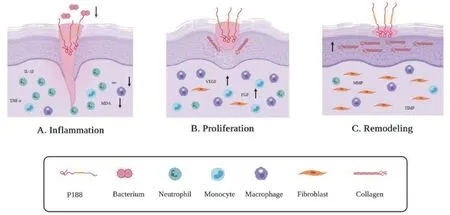
Fig.2.Mechanism of P188 in promoting wound healing.(A) Inflammatory stage:P188 decreases bacterial invasion,seals damaged cell membranes,and inhibits inflammation by reducing MPO and MDA.(B)Proliferation stage:P188 promotes angiogenesis and fibrous tissue formation by increasing the production of VEGF and FGF.(C) Remodeling stage:P188 stimulates high collagen production and re-epithelization.IL-1β,interleukin-1β;TNF-α,tumor necrosis factor α;MPO,myeloperoxidase;MDA,malondialdehyde;VEGF,vascular endothelial growth factor;FGF,fibroblast growth factor;MMP,matrix metalloproteinase;TIMP,tissue inhibitors of metalloproteinase.
5.Application value of P188 in cartilage transplantation
Cartilage consists of an extracellular matrix and chondrocytes,which have been widely used in the field of rhinoplasty as a high-quality graft material.78,79However,owing to the lack of blood vessels,80this application is always facing difficulties such as poor self-repair ability of donor cartilage defects and low survival rates of transplanted cartilage in clinics.81
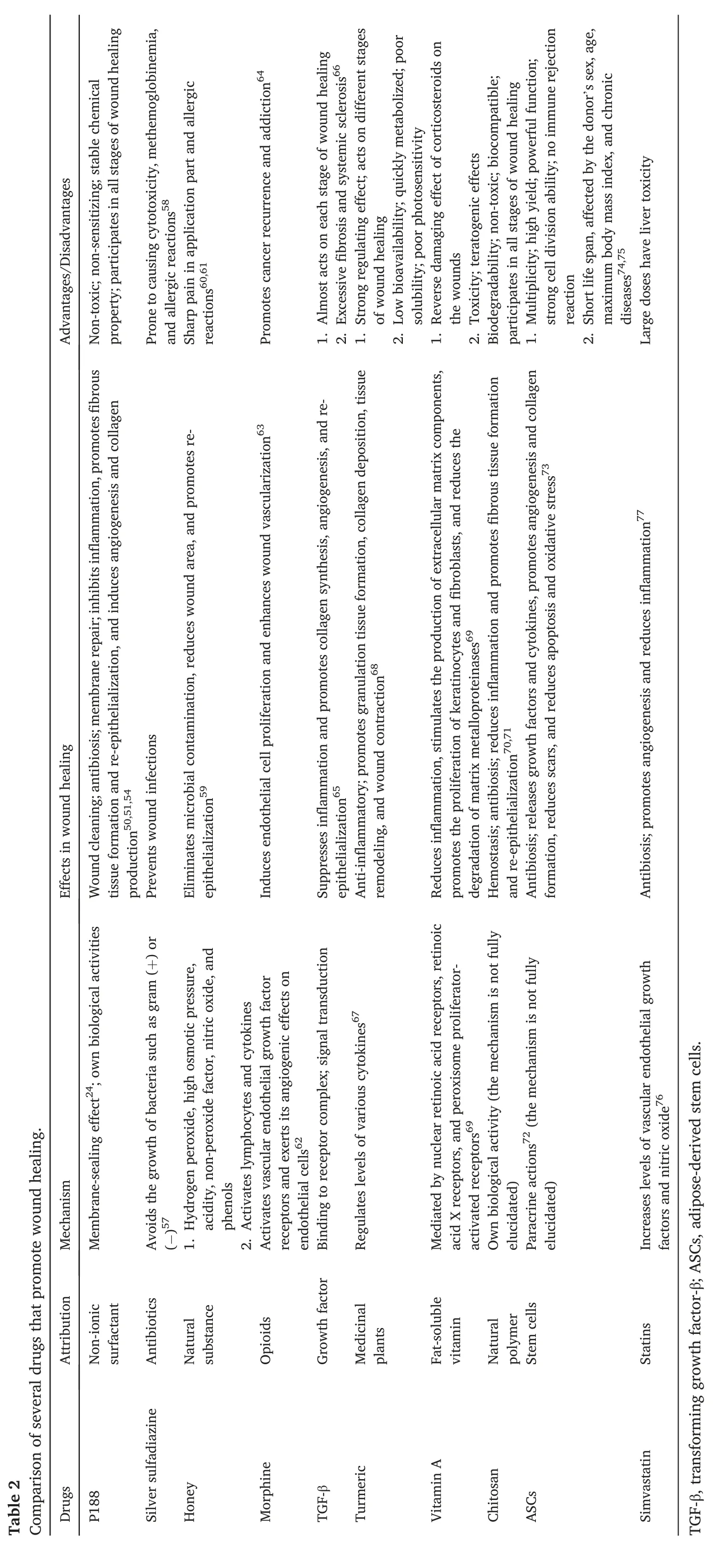
Researchers have discovered that P188 could restore the integrity of damaged chondrocyte membranes in the short term to save chondrocytes from early necrosis and apoptosis.28,82,83Later,Isaac et al.84studied the long-term data of P188 and found the potential long-term efficacy of P188 intervention after chondrocyte trauma.Bajaj et al.85further explored the specific molecular mechanism underlying the protective effects of P188.The experimental results showed that P188 can inhibit the activation of stress-related p38,apoptosis-related GSK3,and inflammation-related IL-6 signaling pathways,indicating that P188 can not only block cell membranes and improve cell survival rate and cartilage integrity but also control the occurrence of inflammation.At present,many scaffolds used in tissue engineering mainly rely on autologous chondrocyte transplantation.Morille et al.12developed a novel polymeric pharmacologically active microcarrier (PAM) containing P188 and evaluated its ability to influence the behavior of mesenchymal stem cells.The final results demonstrated that the new PAMs enhanced the survival and proliferation of mesenchymal stem cells and further promoted the chondrogenesis of mesenchymal stem cells.In a word,these discoveries have suggested that P188 is likely to help solve the current problems associated with cartilage transplantation.
6.Conclusion
This review emphasizes that P188 can improve the survival of fat grafts and cells,participate in wound healing during inflammation,proliferation,and remodeling stages,promote the recovery of cartilage cell integrity,and assist in the induction of cartilage formation,proving its great application potential in autologous fat grafting,wound healing,and cartilage transplantation;this also provides ideas for its therapeutic use in other aspects of plastic surgery(Fig.3).
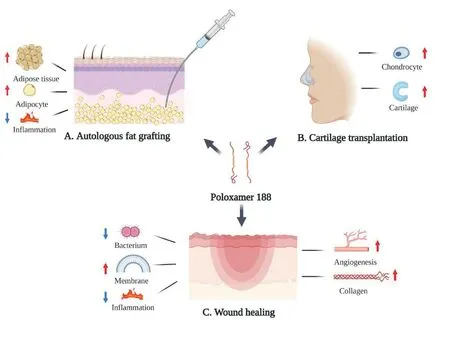
Fig.3.Application of P188 in plastic surgery.(A) Application in autologous fat grafting:P188 increases the activity of fat grafts and adipocytes and reduces inflammation.(B)Application in cartilage transplantation:P188 promotes the survival of chondrocytes and chondrogenesis.(C) Application in wound healing:P188 can resist bacteria,seal cell membranes,reduce inflammation,and also stimulate the regeneration of blood vessels and collagen.
Although P188 has a positive effect on autologous fat grafting,wound healing,and cartilage transplantation,the underlying mechanism and related signaling pathways mediated by P188 remain unclear.These obstacles need to be overcome before the widespread use of P188 in plastic surgery clinics.In addition,3D bioprinting technology has also become promising for plastic surgery in recent years and has powerful effects in the repair and regeneration of various tissues and organs.Compared with traditional tissue engineering methods,this has the advantages of automation,high precision,geometric freedom,and customization and can be used to produce three-dimensional biological structures with complex structures and functions.However,there are still some bottlenecks for its further application in tissue engineering,such as cell activity,vascularization,and the selection and optimization of biological ink materials.P188 has good biocompatibility and printing performance,and simultaneously improves cell activity and promotes angiogenesis and other biological activities.Therefore,P188 could potentially be used as a bio-ink component in 3D bioprinting to achieve synergistic effects for treatments at the plastic surgery level in the future.This might also be worthy of further research and ideas.
Ethics approval and consent to participate
Not applicable.
Competing interests
The authors declare that they have no competing interests.
Author’s contributions
Shang Y:Writing-Original draft.Zhu S:Conceptualization.Nie F:Investigation.Zhen Y:Visualization.Ding P:Investigation.An Y:Writing-Reviewing and Editing,Supervision.Li D:Supervision.Li H:Supervision.
Acknowledgments
The study was supported by the Scientific Research Staring Foundation for the Returned Overseas Chinese Scholars of the Peking University Third Hospital(grant no.BYSYLXHG2019001).
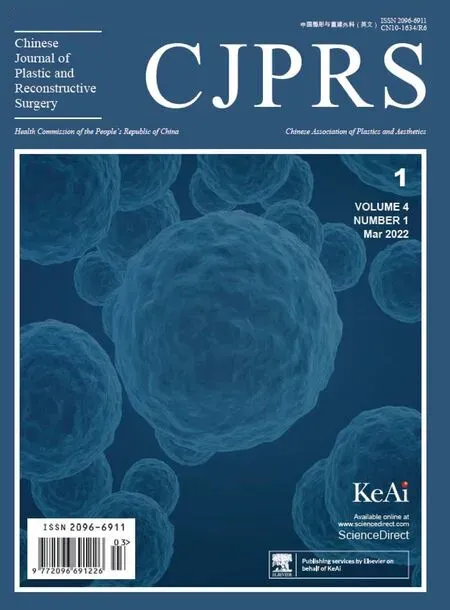 Chinese Journal of Plastic and Reconstructive Surgery2022年1期
Chinese Journal of Plastic and Reconstructive Surgery2022年1期
- Chinese Journal of Plastic and Reconstructive Surgery的其它文章
- Clinical applications of paraumbilical perforator flaps in multiple angiosomes for the reconstruction of the upper limbs
- Foreword from Dr.Chin-Ho Wong
- Effect of local massage on prevention and treatment of intra-arterial polymethyl methacrylate embolism complications:An experimental animal study
- Applying the Passot technique in the surgical treatment of severe gynecomastia:A case report and literature review
- External application of a Nocardia rubra cell wall skeleton in the treatment of diabetic foot ulcers
- Polyacrylamide gel migration after injection for breast augmentation:A case report
